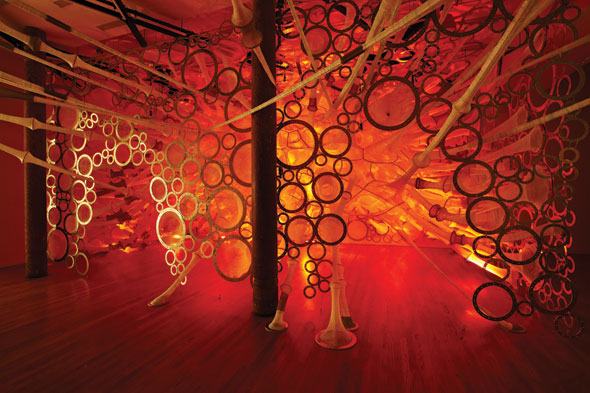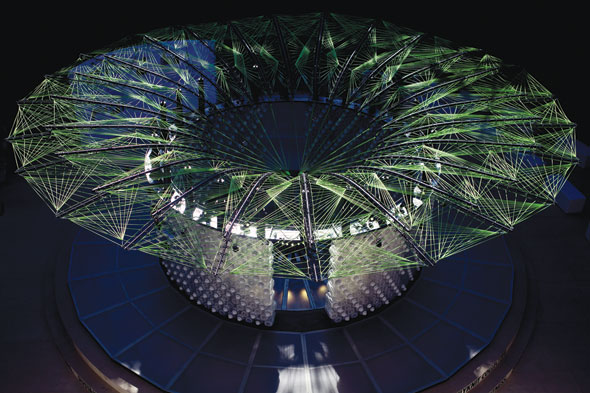
When does an athletic shoe transcend its initial function and become art? How does said sneaker-cum-objet d’art inspire a host of artists of various disciplines to pay tribute to it? It does so when it’s the Nike “Flyknit”—footwear so unique that last July the corporation was granted an injunction against Adidas, who may have disregarded our muse’s patent with their own “Primeknit.” Clicking on the Digital Domain produced “Biomorph” promo, you find yourself viewing what could be the animated version of the “BODIES” exhibit; where a human foot reveals the detail of its skeletal, muscular, nervous system, etc., until crisscrossing textiles intertwine with the human fabrics as if it were a living example of H. R. Giger’s biomech art.
Like M’s hit “Pop Muzik,” (from New York, London, Shanghai, Rio, Milan, and Tokyo), everybody’s talking about the Flyknit Collective. A global union of artists put on workshops with designers and athletes in selected cities where they created their own interpretations of “Performance, Lightness, Formfitting, and Sustainability,” the same principles that guided Nike’s Innovation Kitchen when they created the Flyknit. In New York, the Flyknit Collective’s American Ambassador, Jenny Sabin, presented her “myThread Pavilion,” an installation that fuses architecture, biology, art, and science. London had the Olympic tourists marveling at a pair of installations: Ernesto Neto’s “SwinFlyBaby,” which parallels his brand of biomorphic sculpture with the Flyknit’s “soft architecture;” and UVA’s “Floating Point,” where professional dancers and volunteers from the audience trigger light and sound on a trampoline whose netting and the resulting weightlessness were inspired by Flyknit’s fabrics and “Lightness.”
Arthur Huang’s Shanghai surprise was titled “The Feather,” which pays homage to Flyknit’s “Sustainability,” with an architectural structure made entirely from PET. Ernesto Neto’s second exhibit in Rio de Janeiro, “ObichoSusPensonaPaisaGen,” may resemble a hanging garden made from various colored rope knits—also reminiscent of the sneaker’s fabrics—but it also functions as a crochet jungle gym where you can find yourself surrounded by a large three-dimensional painting; echoing the Fkyknit’s form-fitting experience. The end of 2012 saw an opening in Milan, and the beginning of 2013 belongs to Tokyo. But both feature the LOT-EK design team, who mind-melded with local runners in creating the “Mobile Running Station,” which responded to the runner’s physical demands while pursuing ecological responsibility.
Back in the New York groove, Jenny Sabin’s “myThread Pavilion” was on display at the Nike Bowery Stadium. When she wasn’t too busy in her role as a professor of architecture at Cornell University, Sabin worked with Nike Innovation Kitchen’s Studio Director, Ben Shaffer, conducting two workshops with athletes (another collective called the Bridge Runners) and innovators from all over the Northeast. They were split into teams and equipped with Nike+ and Nike Fuelbands to gather motion data. “This data,” Sabin tells us, “was used as a point of departure in the design of the ‘myThread Pavilion.’ The human motion data was stored in a database, which we linked to a 3D digital-modeling program. Next, we designed algorithms and digital tools to visualize the data in 3D. The pavilion is literally generated by human data in combination with materialconstraints inherent to knit geometry and patterning. What better than to turn to humans for next generation models in architecture?” she asks pragmatically.
Aside from the data, Sabin also had the Flyknit sneaker itself to inspire her: “First of all, the shoes are absolutely gorgeous. They are ingenious examples of 2D knit structures taken into 3D through the vehicle of the human body.” But what inspired her the most was “exploring the possibilities of increasing the scale of these relationships to develop a soft-textile based architectural structure that could be inhabited.” This is the very stuff that is driving her current work and research. Or, as she summarizes, “I work at the intersection of architecture, art, and science and am interested in the unseen structures, qualities, and beauty inherent to data—specifically data from the human body.”

Cerebral when you first hear it, but just dreamy when you get caught up in the installation’s materials: whole-garment, knitted solar active, reflective, and photo luminescent threads, entwined with aluminum laser cut rings and steel-cable net make up the primary structure of her “myThread Pavilion.” Sabin gives us more details: “The soft, textile-based, knitted elements are composed of conducting threads with the capacity to absorb, collect, and deliver energy and light through a unique construction and fabrication process that integrates photo luminescent pigments in synthetic and structural fibers.”
The myThread experience may be something to behold in a gallery setting, but Sabin is quick to remind us “the pavilion and its materials were designed to be outside, whereby the sun would alter and change the material nature of the form. The solar active threads change color in the presence of the sun and the photo luminescent threads absorb UV energy and then slowly emit light at night.”
An artist is just as concerned with what the viewer feels—when immersed in their installation, especially this one, which asks as many questions as it offers answers—as the materials used, or even the socially conscious themes. Sabin is confident that, “as they work their way from the harder edge of the external aluminum ring sets into the soft and inviting nature of the interior form,” they just feel good, as if they’ve found a sweet spot within her work of art.
“Many people have told me,” she concludes, like Arthur C. Clarke’s kindergarten teacher who discovered a way to squeeze naptime in a monolith, “that they want to sleep inside, and the Bridge Runners also use the space frequently to stretch and cool down. The ‘myThread Pavilion’ provides a sense of wonderment and calm, an architectural form that no one has seen before, but there is a sense of connection because the human body is the start and end point.”
For more information, visit nikeflyknitcollective.com
Text by Daniel Siwek

